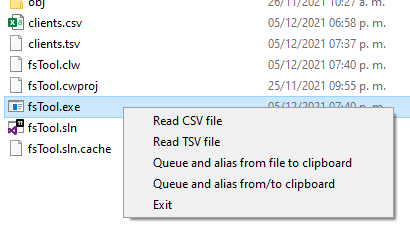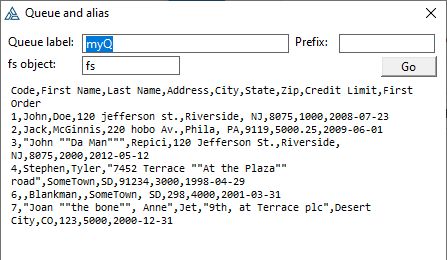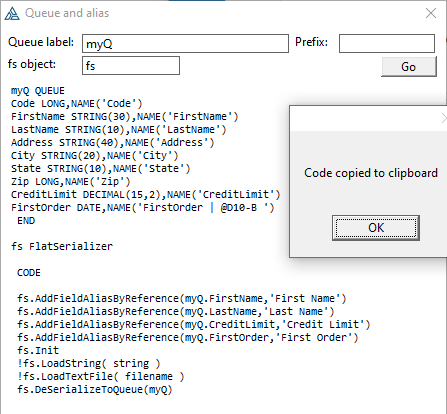A class for serializing and deserializing Clarion structures to Comma (or Tab) Separated Values.
To serialize a queue to a text file:
myQ QUEUE,PRE(myQ)
id LONG
Name STRING(30)
Date DATE
Time TIME
END
fs FlatSerializer
CODE
...
fs.Init
fs.SerializeQueueToTextFile(myQ,'testqueue.csv')
The resulting testqueue.csv text file will look like this:
ID,NAME,DATE,TIME
5,"Some Name",2021-07-30,18:45:56
7,"Another Name",2021-12-16,08:12:34
To load the same text file to a queue:
FREE(myQ)
fs.Init
fs.LoadTextFile('testqueue.csv')
fs.DeSerializeToQueue(myQ)
You can also query a value in a particular value by name and line number:
fs.Init
fs.LoadTextFile('testqueue.csv')
loc:name = fs.GetValueByName('Name',2) !Column "NAME", line 2: "Another name"
Some of the features:
- Serializes groups, queues and files to a string or text file.
- Deserializes a string or text file to groups, queues or files.
- Can read the value of any column by name and line number.
- Handles new lines, commas (or tabs) and escaped (doubled) quotes inside quoted strings.
- Can be configured to use tabs instead of commas, or alternative line break and quote symbols.
- Detects the data type of fields (number, string, date or time) and formats them (with configurable date and time pictures).
- When serializing, fields in the structure can be excluded by name or by reference.
- When deserializing, fields in the structure can have multiple aliases.
- Handles
NAME()with "extended | attributes". - Removes prefixes by default.
- Can be configured to use quotes in strings only when needed (the string contains new lines or commas).
- Includes a tool to create a queue declaration and sample code from a csv file or text from the clipboard
Copy FlatSerializer.clw and FlatSerializer.inc to the app folder or a folder in your .red file, like Accessory\libsrc\win.
Add to a global data embed (like After Global INCLUDEs) the line:
INCLUDE('FlatSerializer.inc'),ONCE
In your procedure or routine, declare an instance, and start coding:
fs FlatSerializer
CODE
fs.Init
fs.LoadTextFile('testqueue.csv')
fs.DeSerializeToQueue(myQ)
Init
Init (<STRING pColumnSep>,<STRING pLineBreakString>,<STRING pQuoteSymbol>)
InitTSV
Initializes the instance.
Parameters
- ColumnSep: String to use to separate columns. Default is
','(comma) - LineBreakString: String to use to separate lines. Default is
'<13,10>'(cr/lf) - QuoteSymbol: Symbol to use to quote strings. Default is
'"'(double quote)
Method InitTSV configures the instance to handle Tab Separated Values, is equivalent to:
fs.Init('<9>')
fs.SetAlwaysQuoteStrings(FALSE)
SetColumnSeparator (STRING)
SetLineBreakString (STRING)
SetQuoteSymbol (STRING)
Change defaults form column separator, line break and quotes. Defaults are ',' '<13,10>' and '"'.
SetDatesPicture (STRING)
SetTimesPicture (STRING)
Change default pictures for dates and times. Defaults are '@D10-B'
(yyyy-mm-dd) and '@T04B' (hh:mm:ss).
SetIncludeHeaders (BOOL)
SetAlwaysQuoteStrings (BOOL)
SetRemovePrefixes (BOOL)
SetSerializeUsingAlias (BOOL)
SetReadLinesWithoutColumnSeparators (BOOL)
Change the behavior of the instance:
- Inclue Headers (default
TRUE): If the serialized string or file should include the column names in the first line. - Always Quote Strings (default
TRUE): If the string fields should always be enclosed with quote symbols. If set toFALSE, quotes are only used if the string includes a comma or new line. - Remove Prefixes (default
TRUE): If the structure's prefix should be removed from the field name. - Serialize Using Alias (default
FALSE): Use the first alias added withAddFieldAliasByReferenceas column name when serializing, overriding the fields label andNAMEattribute. - ReadLinesWithoutColumnSeparators (default
FALSE): When set to the defaultFALSE, the class will ignore lines that don't have at least one comma. Useful if the file include titles or documentation in the first few lines. Should be set toTRUEif reading files with only one column.
AddExcludedFieldByName (STRING pField)
AddExcludedFieldByReference (*? pField)
Excluded fields in group or queue from the output.
SerializeGroupNames (*GROUP pGroup),STRING
Returns a line with the names of the columns based on the group structure declaration.
SerializeGroupValues (*GROUP pGroup),STRING
Returns a line with the values of the columns based on the group structure.
SerializeGroup (*GROUP pGroup),STRING
SerializeQueue (*QUEUE pQueue),STRING
SerializeFile (*FILE pFile,<*KEY pFileKey>),STRING
Returns a string with headers and values based on the passed Clarion structure.
- FileKey (default first key in the file declaration): Key to use to read the file.
SerializeGroupToTextFile (*GROUP pGroup,STRING pFileName)
SerializeQueueToTextFile (*QUEUE pQueue,STRING pFileName)
SerializeFileToTextFile (*FILE pFile,STRING pFileName,<*KEY pFileKey>)
Creates a text file with headers and values based on the passed Clarion structure.
- FileKey (default first key in the file declaration): Key to use to read the file.
AddFieldAliasByReference (*? pField,STRING pAlias)
Add an alternative name to a field. Useful if the header of a column includes spaces, or can have different names.
LoadString (STRING pText)
LoadTextFile (STRING pFileName)
Load and parse a string or text file. Should be called before deserializing of before getting values.
GetLinesCount (),LONG
Number of lines with values loaded.
GetValueByName (STRING pColumnName,LONG pLineNumber = 1,LONG pDeformatOptions = fs:DeformatAll),STRING
Returns a string with the value of the named column at a particular line number.
- DeformatOptions: One or more flags:
fs:DeformatDates,fs:DeformatTimes,fs:DeformatCommas,fs:DeformatAllorfs:DeformatNothing
Example:
fs.Init
fs.LoadTextFile('testqueue.csv')
LOOP lin = 1 TO fs.GetLinesCount()
loc:name = fs.GetValueByName('Name',lin,fs:DeformatCommas) !remove commas from numbers, leave dates and times as is
END
GetColumnsCount (),LONG
Number of columns loaded.
GetColumnName (STRING pColumnNumber),STRING
Returns a string with the name of the column.
Example:
fs.Init
fs.LoadTextFile('testqueue.csv')
LOOP col = 1 TO fs.GetColumnsCount()
loc:colname = fs.GetColumnName(col)
END
DeSerializeToGroup (*GROUP pGroup,LONG pLineNumber = 1)
DeSerializeToQueue (*QUEUE pQueue)
DeSerializeToFile (*FILE pFile)
Fills the fields in the structure with the corresponding loaded column values and, for queues and files, adds a new record for each line.
DebugView (STRING pStr)
Writes string to debug output.
There is a tool in folder fsTool with these options:
- Read CSV file: Reads a CSV file and shows the number of columns, lines, names of columns and the values of the first and last line.
- Read TSV file: Does the same for TSV files
- Queue and alias from file to clipboard: Reads a CSV or TSV file, shows a window to enter info like queue label, and creates the queue declaration and code
- Queue and alias from/to clipboard: Does the same but reads the CSV text from the clipboard (and rereads it every time the window gains focus).



